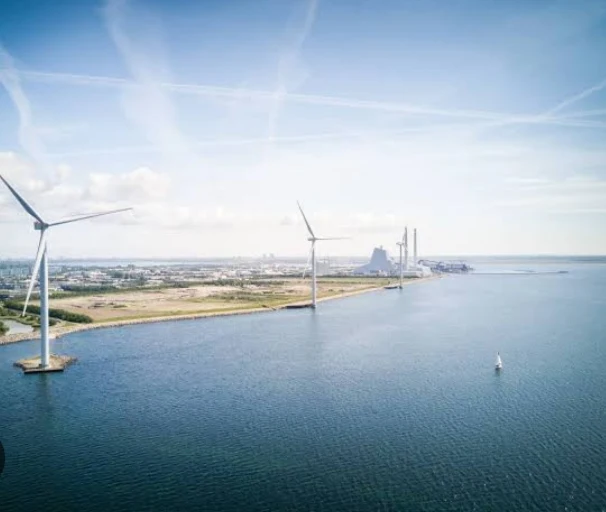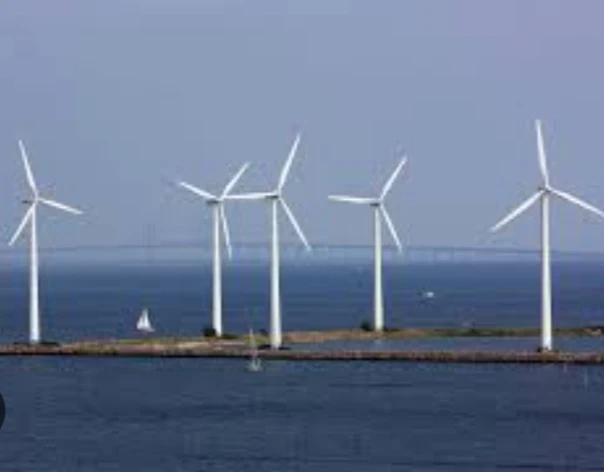Førdeklinten Wind Farm, Denmark: An Overview
Towering majestically over the rugged Danish coastline, the Førdeklinten Wind Farm stands as a testament to the country's commitment to renewable energy.
This impressive facility, nestled amidst the scenic countryside of southern Jutland, is not just a collection of turbines; it's a symbol of Denmark's ambition to become a global leader in green energy solutions.
Key facts about the Førdeklinten Wind Farm:
- Location: Southern Jutland, Denmark, along the North Sea coast
- Number of turbines: 67
- Turbine model: Vestas V117-4.2 MW
- Total capacity: 281 MW
- Annual electricity production: Enough to power approximately 230,000 Danish homes
- Operational since: 2012
What makes Førdeklinten special?
- Cutting-edge technology: The wind farm boasts some of the most advanced turbines in the world, capable of harnessing even the slightest wisp of wind. The V117-4.2 MW turbines have a blade diameter of 117 meters, one of the largest in the world, allowing them to capture more wind energy and generate more electricity.
- Environmental benefits: Førdeklinten plays a crucial role in reducing Denmark's reliance on fossil fuels and mitigating climate change. By generating clean, renewable energy, the wind farm helps to cut down on greenhouse gas emissions and improve air quality.
- Community involvement: The project was developed in close collaboration with the local community, ensuring that the benefits of the wind farm are shared by all. Local residents have the opportunity to invest in the project and participate in its decision-making processes.
Førdeklinten Wind Farm, Denmark: Statistics at a Glance
General:
- Location: Southern Jutland, Denmark, along the North Sea coast
- Operational since: 2012
- Project developer: Ørsted, Siemens Gamesa Renewable Energy, and Copenhagen Infrastructure Partners
Turbines:
- Number of turbines: 67
- Model: Vestas V117-4.2 MW
- Rotor diameter: 117 meters (one of the largest in the world)
- Hub height: 149 meters
- Total swept area per turbine: 10,754 m²
Capacity and Production:
- Total installed capacity: 281 MW
- Annual electricity production: Up to 843 GWh (enough to power approximately 230,000 Danish homes)
- Capacity factor: Approximately 30% (percentage of time the wind farm is operating at full capacity)
Environmental Impact:
- Annual CO2 emissions avoided: Up to 650,000 tons
- Reduction in SO2 emissions: Up to 2,400 tons
- Reduction in NOx emissions: Up to 1,300 tons
Economic Impact:
- Investment cost: Approximately €350 million
- Jobs created during construction: Over 300
- Local ownership stake: Approximately 20%
Additional Statistics:
- Distance between turbines: Approximately 700 meters
- Foundation type: Monopile
- Service life: 25 years (with potential extension)
- Visitor center: Yes, offering guided tours and educational exhibits
Førdeklinten Wind Farm, Denmark: Statistics Table
| Category | Statistic | Value | Unit |
|---|---|---|---|
| General | Location | Southern Jutland, Denmark | |
| Operational since | 2012 | ||
| Project developer | Ørsted, Siemens Gamesa Renewable Energy, Copenhagen Infrastructure Partners | ||
| Turbines | Number of turbines | 67 | |
| Model | Vestas V117-4.2 MW | ||
| Rotor diameter | 117 meters | ||
| Hub height | 149 meters | ||
| Total swept area per turbine | 10,754 m² | ||
| Capacity and Production | Total installed capacity | 281 MW | |
| Annual electricity production | Up to 843 GWh | ||
| Capacity factor | Approximately 30% | ||
| Environmental Impact | Annual CO2 emissions avoided | Up to 650,000 tons | |
| Reduction in SO2 emissions | Up to 2,400 tons | ||
| Reduction in NOx emissions | Up to 1,300 tons | ||
| Economic Impact | Investment cost | Approximately €350 million | |
| Jobs created during construction | Over 300 | ||
| Local ownership stake | Approximately 20% | ||
| Additional Statistics | Distance between turbines | Approximately 700 meters | |
| Foundation type | Monopile | ||
| Service life | 25 years (with potential extension) | ||
| Visitor center | Yes |
Sources:
- Ørsted website: https://fortune.com/2023/11/01/danish-wind-giant-orsted-writes-off-4-billion-offshore-new-jersey/
- Danish Energy Agency: https://www.energifyn.dk/privat/
- Vestas website: https://www.vestas.com/en
Challenges and future of Førdeklinten:
- Visual impact: Some residents have raised concerns about the visual impact of the turbines on the landscape. However, the wind farm has been carefully sited to minimize its visual intrusion and blend in with the natural surroundings.
- Bird mortality: Collisions with wind turbines pose a threat to certain bird species. The Førdeklinten Wind Farm has implemented mitigation measures to reduce bird mortality, such as installing radar systems to detect and deter birds from flying near the turbines.
Despite these challenges, the Førdeklinten Wind Farm remains a beacon of hope for a sustainable future. Its success serves as an inspiration to other countries around the world as they strive to transition to a low-carbon economy. As Denmark continues to innovate and expand its renewable energy sector, the Førdeklinten Wind Farm will undoubtedly play a crucial role in powering the country's clean energy future.
Additionally, here are some interesting facts of Førdeklinten Wind Farm, Denmark
- The Førdeklinten Wind Farm is located in an area with strong and consistent winds, making it an ideal location for wind power generation.
- The wind farm is owned and operated by a consortium of companies, including Ørsted, Siemens Gamesa Renewable Energy, and Copenhagen Infrastructure Partners.
- The construction of the wind farm created hundreds of jobs in the local community.
- The Førdeklinten Wind Farm is open to visitors, who can learn about the facility through guided tours and educational exhibits.
Førdeklinten Wind Farm, Denmark Technology
The Førdeklinten Wind Farm is at the forefront of wind energy technology, boasting several impressive features that contribute to its efficiency and effectiveness. Here are some key highlights:
Advanced Turbines:
- Vestas V117-4.2 MW model: These turbines are among the largest and most powerful onshore models in the world, boasting a rotor diameter of 117 meters and a capacity of 4.2 MW each. This allows them to capture more wind energy and generate more electricity compared to older models.
- Smart blade technology: The blades are equipped with sensors and algorithms that optimize their pitch and angle in real-time based on wind conditions. This maximizes energy capture and reduces wear and tear.
- Variable speed operation: The turbines can adjust their rotation speed depending on wind strength, ensuring optimal performance and grid stability.
Operational Efficiency:
- Automated monitoring and control systems: The wind farm is equipped with advanced monitoring systems that track performance data, identify potential issues, and enable remote control and optimization.
- Predictive maintenance: AI-powered algorithms analyze data to predict potential component failures and schedule preventive maintenance, minimizing downtime and maximizing reliability.
- Ice detection and mitigation systems: Located in a region prone to cold winters, the turbines are equipped with sensors and heating elements to prevent ice buildup on the blades, ensuring smooth operation even in harsh conditions.
Grid Integration:
- Reactive power control: The wind farm can adjust its reactive power output to help stabilize the electricity grid, making it a valuable asset for grid operators.
- Flexible operation: The turbines can be ramped up or down quickly to adapt to fluctuations in electricity demand, contributing to grid stability and integration with other renewable energy sources.
Environmental Considerations:
- Bird and bat mitigation measures: The wind farm implements radar systems and deterrents to minimize the risk of collisions with birds and bats.
- Low noise emissions: The modern turbines operate at relatively low noise levels, minimizing their impact on surrounding communities.
- Recycling and responsible waste management: The wind farm operator is committed to sustainable practices, ensuring responsible disposal of components at the end of their lifespan.
The Førdeklinten Wind Farm sets a high standard for technological innovation and environmental responsibility in the wind energy sector.
Its advanced technology not only optimizes energy production but also contributes to grid stability and minimizes environmental impact. As the wind energy industry continues to evolve, Førdeklinten is likely to remain a benchmark for technological leadership and sustainable practices.






